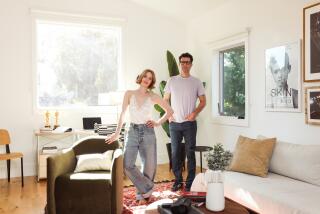Not your father’s office
In an era when the dividing line between work and home life is increasingly blurred, architects Robin Donaldson and Russell Shubin design offices that feel a lot like home, even if they look like something out a sci-fi movie. Hard-edged and avant-garde, oozing with attitude and moody lighting, the interiors created by Shubin and Donaldson--two men in their 40s who shuttle between offices in Culver City and Santa Barbara--are a world away from the paneled-wood boardrooms of yesteryear.
“There has been a convergence between how people live and how people work,” Donaldson says. “It’s not always clear where the boundary lies between the two.” Corporate clients, he says, “want the amenities of home: a kitchen, a rec area, a place to kick back and watch TV, even rooms for sleeping and showering.” At first glance, you wouldn’t call the offices of Mindfield homey. The interiors of the Marina del Rey-based production and post-production company are dark, edgy, artsy and brooding. The dim atmosphere reflects the preference for low lighting among people who work in video editing and hate the glare of sunlight on their monitors. Natural light filters in through a wall of patterned plexiglass. The diffused light provides a soothing atmosphere that Shubin playfully calls “Zen/Gothic.”
A closer look reveals the influence of home design in the clear demarcation between public and private areas. In the center of Mindfield is a large sitting area, much like a living room. Scattered throughout the work area are six individual editing bays designed to look like huts, which could be likened to bedrooms. The architects used an undomestic material--unfinished sheet metal--for the editing huts, and the imagery is almost menacing, with sloping walls that recall the distorted architecture of German Expressionist movies such as “The Cabinet of Dr. Caligari.” Inside, however, the huts are quiet and soothing, even cozy. One video editor feels comfortable enough to burn candles in his hut.
Jim Smith, chairman of the Marina del Rey-based ad agency Ground Zero, a partner with the adjacent Mindfield, says, “A sense of privacy is very important, because it gives the staff a certain feeling of relaxation and informality.” That feeling of privacy is far preferable to that offered in a typical office layout, he adds, which often is little more than a reception desk in front and an open work area in back. “It’s like you are in the DMV,” he says.Similarly, at the offices of advertising heavyweights Ogilvy & Mather in Culver City, the open work area is punctuated with quiet, enclosed spaces, such as a small research library and an editing room. But here design works around brightly lit spaces, such as the structure’s front facade of floor-to-ceiling glass that faced the sun. To shield the interior from direct sunlight, Shubin and Donaldson created a dramatic entrance sequence--a metal tube--located along the window wall.
The tube makes the act of walking into the Ogilvy & Mather offices a surprising, almost otherworldly, experience. After passing through steel doors, the visitor enters a metal round tube, “like the fuselage of a small commercial jet,” Shubin says. Walking down the tube, visitors pass by several television monitors displaying the international ad agency’s latest commercials, such as those for Miller Lite, American Express and Mattel. Pinpricks of sunlight poke through walls of perforated metal. At the end of the 44-foot tunnel is another surprise: a 16-foot-high wall emblazoned with the face of the late David Ogilvy, the legendary ad man who founded the firm in 1948. That wall is symbolic of the boundary between the world-at-large and the exclusive corporate culture of the agency.
Tailoring a difficult space to the particular needs of a client is a challenge Shubin and Donaldson face regularly. When the team first looked at a former banking branch office in Beverly Hills, where The Firm, a talent agency, planned to move, it found a dark, depressing space with windows on one wall only. Ductwork cluttered the 30-foot-high exposed ceiling. Three enormous columns, covered in tasteless marble veneer, stood in the center of the room.
Lighting was the first task. After peeling the marble off the columns, the architects outfitted the now-naked concrete columns with banks of “down lights” pointed toward the floor and “up lights” for the ceiling to remove shadows. In addition, the architects built a 14-foot-high perimeter wall of translucent glass that wraps around the interior walls of the talent agency. Fluorescent lighting behind the glass beams inward into the office, washing the room in a soft, even light. Individual desks have task lighting.
The architects removed the ductwork and wiring from the exposed ceiling and relocated the building’s “guts” onto two newly built mezzanine floors--conveniently hidden behind the new wall of translucent glass.
Like many defunct bank buildings, The Firm’s office features a large walk-in bank vault, impossible to remove and awkward to remodel. The architects furnished it with home-like materials, such as a shag rug, comfortable furniture, media center and plants. They sound-proofed the metal vault with Homesote, a carpet underlay that looks surprisingly like brushed suede. Now the vault has a hip, loungey look, and the soundproof environment has become a hot spot for watching client videos or listening to music.
In the workplaces of Shubin and Donaldson, even a bank vault feels like home.


